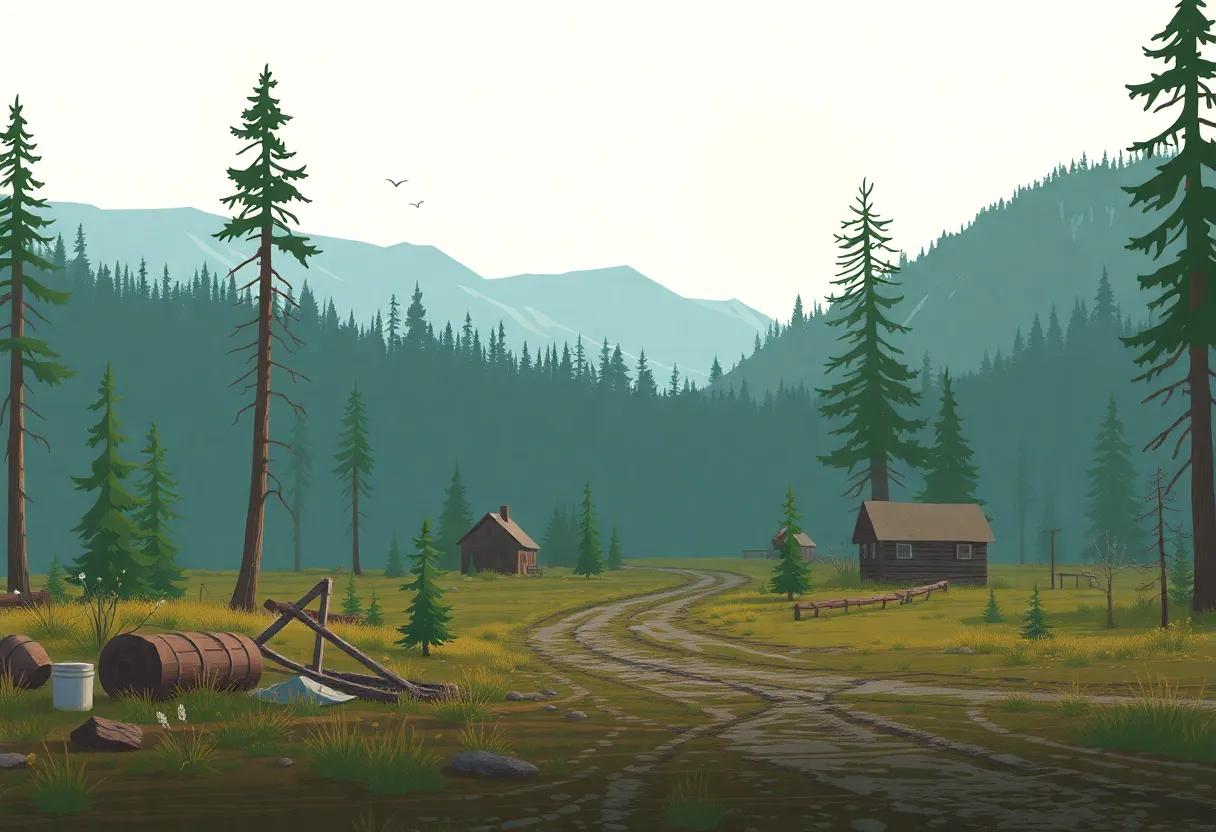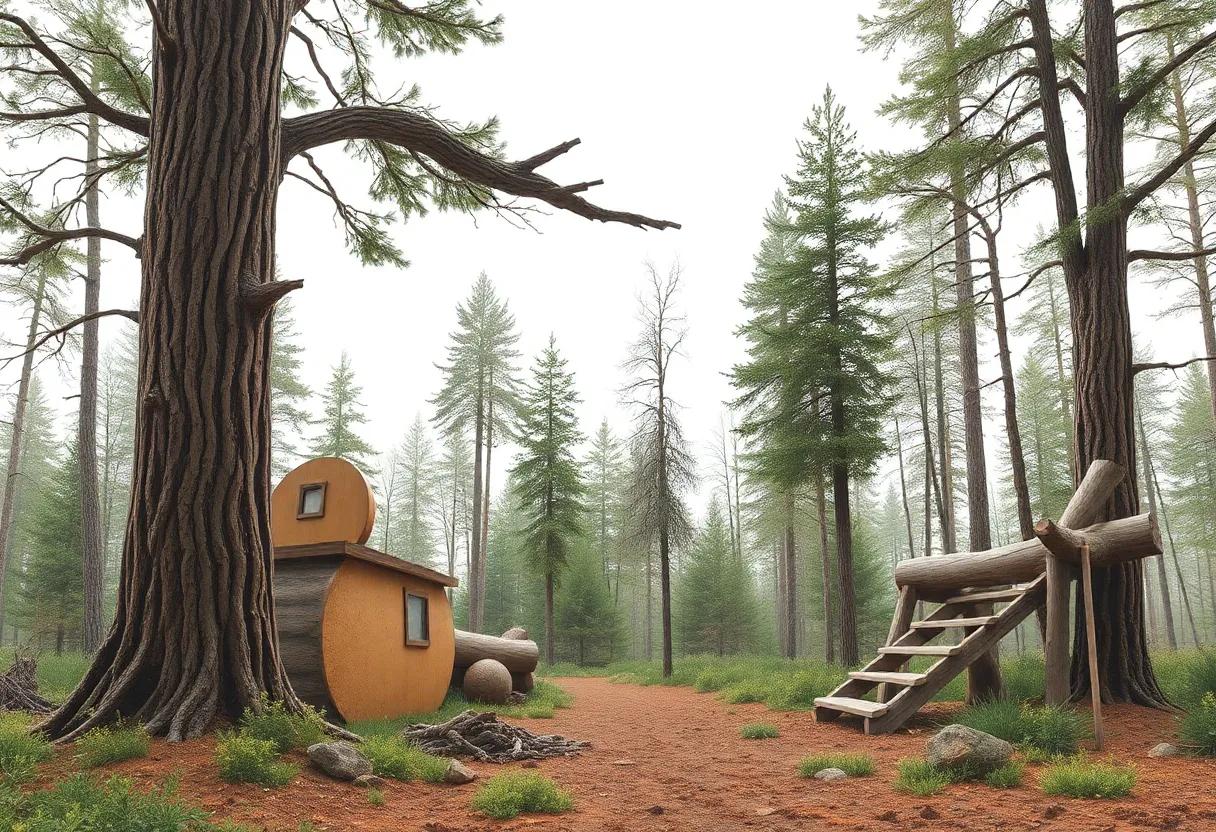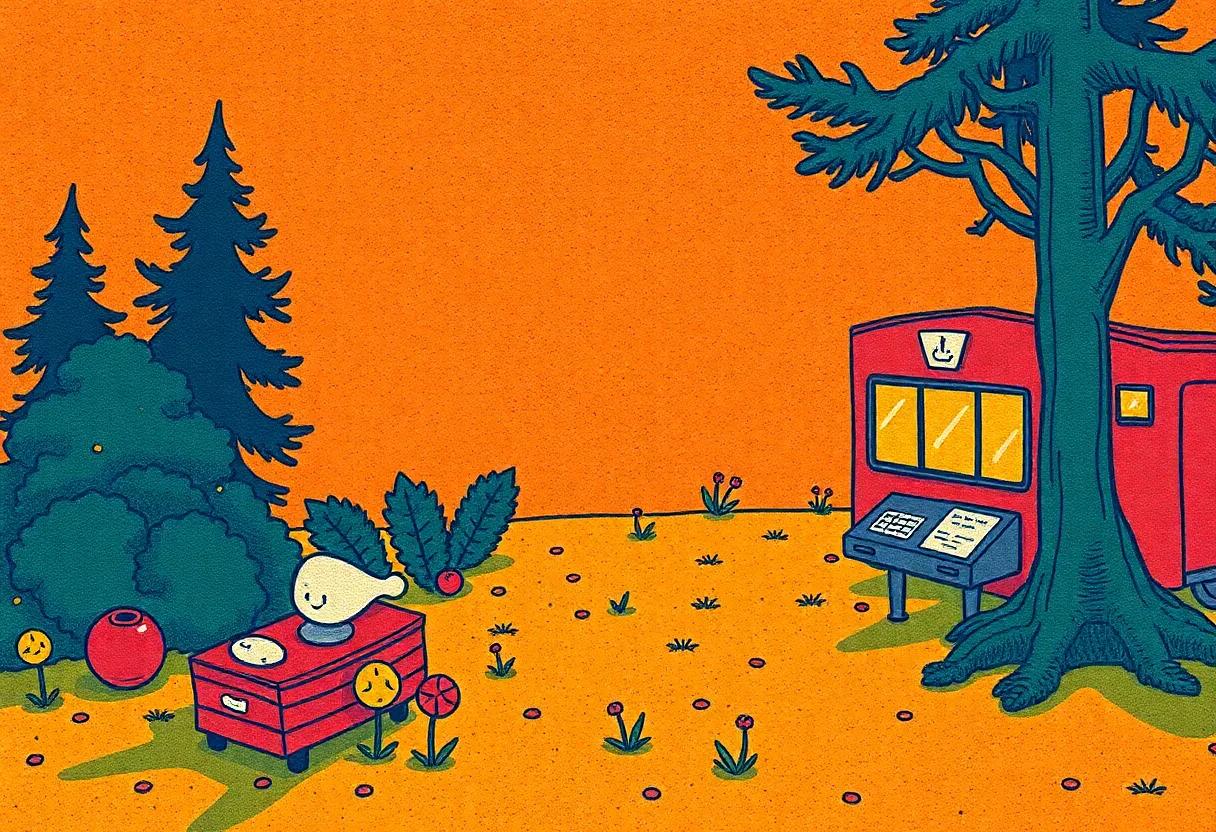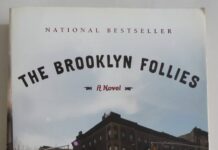In the vast forest of American literature, Ken Kesey’s Sometimes a Great Notion stands as a towering, complex tree-its roots tangled deep in themes of family, identity, and resilience. invites readers to step beyond familiar pathways and explore this classic novel through new perspectives.This insightful work peels back layers of Kesey’s intricate narrative, offering a thoughtful reexamination that neither idolizes nor dismisses, but instead seeks to understand the enduring power and raw challenges embedded in his storytelling. As we delve into this review, we uncover how the book navigates the dense undergrowth of Kesey’s characters and themes, shedding light on what makes Sometimes a Great Notion a lasting emblem of American fiction.
Exploring the Complex Family Dynamics That Drive the Heart of Kesey’s Sometimes a Great Notion With Unflinching Realism
Ken Kesey’s narrative excels in unpacking the tangled web of relationships within the Stamper family, delving deep into how pride, stubbornness, and loyalty intertwine to both bind and fracture their bonds.The Stamper clan’s clashes aren’t merely about external struggles on the timber-frontier but serve as vivid metaphors for generational conflict and individual identity. Each character wrestles with inheritance-not just of land and livelihood,but of old grudges and unyielding values that fuel their relentless drive. Through raw dialog and rich characterization, Kesey exposes the fragile architecture of family, making every confrontation pulse with the heavy weight of unspoken history.
In exploring these dynamics, Kesey doesn’t shy away from complexity; instead, he embraces unflinching realism, presenting a family whose unity is both their strength and their undoing. Consider this breakdown of Stamper family tensions:
| Family Member | Core Conflict | Symbolic Role |
|---|---|---|
| Henry Stamper | Unyielding independence vs. communal loyalty | Patriarch battling tradition |
| Leland Stamper | Rebellion against paternal legacy | The restless challenger |
| joe Ben Stamper | Mediator caught in crossfire | Bridge between generations |
- Stubborn pride: Acts as both shield and barrier among family members.
- Love and resentments: coexist in a tension-filled balance, shaping every decision.
- Economic survival: Constantly pressures family loyalty and fractures.
A deep Dive into the Environmental and Economic Struggles that Shape the Rugged Landscape of Kesey’s timber Town Setting

In Kesey’s rugged timber town, the environmental hostility is more then just a backdrop-its a living force that shapes every aspect of life. Towering pines and dense forests create both a sanctuary and a battleground,where the timber industry’s relentless appetite clashes with the fragile ecosystem. The ceaseless rains saturate the earth, turning logs into perilous loads on muddy trails, while the ever-present threat of landslides and floods reminds inhabitants of nature’s unforgiving grip. These natural challenges intensify the precariousness of daily work,embedding a sense of rugged resilience among the locals,who understand that their livelihoods are woven tightly with the surrounding wilderness.
Economic pressures further complicate this landscape, striking at the heart of the timber town’s survival. Here, seasonal fluctuations and fluctuating timber prices dictate stability, forcing families into cycles of uncertainty. The town’s economy hinges on a delicate balance: profit margins must stretch to sustain logging operations, yet safety and conservation concerns demand costly compromises. Below is a snapshot of how these forces interact:
| Factor | impact on Community | Economic Result |
|---|---|---|
| Weather Variability | Inconsistent workdays and hazardous conditions | reduced timber output and increased downtime |
| Market Demand | Fluctuating wages and job security | Pressure to maximize harvest regardless of environmental cost |
| Regulatory Restrictions | Limits on logging areas and techniques | Increased operational costs and strained family economies |
- Intergenerational debt: Families caught between tradition and modernization.
- Environmental stewardship: Constant debate over sustainable practices versus short-term gains.
- Community solidarity: A fragile bond tested by external economic forces and internal conflicts.
How Kesey’s Narrative Style Blends Stream of Consciousness with Multiple Perspectives to Enrich the Reader’s Experience

Kesey’s narrative style intricately weaves a tapestry that simultaneously captures the fragmented nature of consciousness and the complexity of family dynamics. By employing a stream of consciousness approach, readers gain intimate access to the raw, unfiltered thoughts of characters as their minds drift between past memories and present turmoil. This technique plunges the audience deeply into the emotional undercurrents of the story, allowing for a more profound empathy with each individual’s struggles and desires. Instead of linear progression, the narrative feels like the pulse of a living, breathing family – erratic, intense, and layered.
Adding depth to this immersive experience, Kesey shifts the narrative spotlight between multiple perspectives, presenting a multifaceted view of events and personalities. This polyphonic structure not only enriches the storytelling but also challenges readers to assemble a cohesive understanding from diverse, sometimes conflicting, viewpoints. The result is a dynamic exploration of themes like loyalty,pride,and isolation. Consider the following breakdown of perspectives and their impact:
| Outlook | contribution to Narrative | Emotional Tone |
|---|---|---|
| Hank | Brash, steadfast voice highlighting family pride and stubbornness | Fiery, relentless |
| Leland | Reflective, burdened perspective revealing internal conflict | Melancholic, contemplative |
| brew | Younger generation’s lens showing frustration and search for identity | Restless, uncertain |
- Immersive psychological depth: Stream of consciousness unmasks characters’ motivations.
- Complex family portrait: Multiple perspectives reveal conflicting emotions and alliances.
- Dynamic narrative rhythm: Shifts in viewpoint mimic the turbulent flow of family life.
Unpacking the Symbolism of Timber and Nature as Metaphors for Resilience and Conflict Within the Stamper Family Saga

In the heart of Kesey’s narrative, timber transcends its physical form, becoming a living symbol of the Stamper family’s indomitable spirit. The dense forests surrounding their homestead are not merely a backdrop but a mirror reflecting the intricate dynamics of resilience and conflict that pulse through their lineage. Just as the towering trees withstand relentless storms, the Stamper family grapples with turbulent emotions, deep-rooted grudges, and unyielding pride. Each felled log and split board embodies not only the fruits of their sweat and toil but also the fractures and tensions simmering beneath the surface of their unity. The relentless cycles of nature echo the family’s persistence and the harsh realities they confront, intertwining the natural world with human endurance in a profound and unresolved dance.
Consider the duality of nature’s influence represented in this saga-while the forest offers an unbreakable strength, it also presents an unforgiving volatility that mirrors the Stamper clan’s internal strife. This paradox is skillfully illustrated in the following table, highlighting nature’s dual roles as both a sanctuary and a battleground within the story:
| Nature as Resilience | Nature as Conflict |
|---|---|
| Roots intertwining securely | branches clashing violently in the wind |
| Seasonal regrowth and renewal | Wildfires threatening to consume everything |
| Quite strength of ancient pines | Storms tearing through the canopy |
- Timber as legacy: A tangible link between generations, forged through shared hardship.
- Nature as character: An influential, almost sentient force shaping destinies.
- Conflict embodied: The natural world’s harshness reflecting human discord and survival struggles.
the Role of Regional Dialect and Cultural Nuance in Bringing Authenticity and Texture to Kesey’s Pacific Northwest Community

Kesey’s masterful use of regional dialect is more than just a stylistic choice; it serves as a living, breathing element that roots the narrative deep within the rugged Pacific Northwest. The colloquialisms, the cadence, and the tough, no-nonsense speech all mirror the working-class timber community’s raw resilience and intimate connection to their land. Through characters who speak with sharp, authentic voices, readers can almost hear the crunch of boots on forest floor and the hum of sawmills in the background. This linguistic texture paints a vivid auditory landscape, inviting us not merely to observe but to inhabit the nuances of daily life in a timber town, where family and forestry are inseparable threads woven into the region’s cultural tapestry.
Alongside dialect, kesey’s nuanced portrayal of cultural values amplifies the community’s unique texture, emphasizing themes like fierce independence, loyalty, and the inescapable pull of family legacy. To better understand how these motifs interact, consider the table below, which contrasts characteristics of Kesey’s timber community with more generalized american cultural traits:
| Kesey’s Timber Community | General American Traits |
|---|---|
| Interdependence among family and neighbors | Emphasis on individualism |
| Strong oral storytelling tradition | Written narratives dominant |
| Respect for the land as a sustaining force | Nature often seen as resource or backdrop |
| Loyalty to family legacy above all else | Mobilized by new opportunities and change |
- Dialect acts as a cultural fingerprint, anchoring the story’s setting and characters.
- Cultural values create a textured backdrop of tradition versus modernization.
- Community interactions highlight complex interpersonal dynamics unique to the Pacific Northwest timber lifestyle.
Examining the Themes of Individualism Versus Collective Responsibility in the Context of Labor Disputes and Family Loyalty
Ken Kesey’s narrative weaves a complex tension between the fiercely autonomous spirit of Hank Stamper and the communal ethos embodied by the union workers opposing the timber-cutting practices. This conflict is not simply labor versus management-it encapsulates a deeper struggle where individual ambition clashes with collective welfare. Hank’s relentless drive to keep the family business afloat, often at odds with union solidarity, illuminates how personal determination can both empower and isolate.His choices challenge conventional notions of loyalty, revealing that sometimes the bond of blood demands sacrifices that ripple beyond economic considerations.
The Stamper family serves as a microcosm for the broader societal dilemma: how to balance personal convictions with the weight of communal expectations. Their fracturing relationships illustrate that family loyalty is rarely a black-and-white allegiance. Instead, it is a layered mosaic of support, resentment, and resilience.Consider the following dynamics:
- Hank’s obstinacy: emblematic of rugged individualism, risking unity for principle.
- Union’s solidarity: underscoring the power and vulnerability inherent in collective action.
- Family ties: complicated by conflicting roles, fostering both strength and discord.
| Theme | Symbol | Impact on Characters |
|---|---|---|
| Individualism | Hank’s relentless work ethic | Isolation, determination, conflict |
| Collective Responsibility | Union strikes | Solidarity, pressure, compromise |
| Family Loyalty | Stamper household | Unity, fracture, endurance |
Insightful Comparisons Between Sometimes a Great Notion and Kesey’s other Works that Illuminate His Evolving Literary Voice
Sometimes a Great Notion represents a turning point in Ken Kesey’s literary journey, where his exploration of individualism is intertwined with the relentless forces of family loyalty and community struggle. unlike the psychedelic rebellion and youthful exuberance that dominate One Flew Over the Cuckoo’s Nest,this novel dives deep into the grueling realities of working-class life in the Pacific Northwest. Kesey’s prose here is denser, more rugged, mirroring the timberlands and stubborn spirit of the Stamper family. Through its multi-perspective narrative, Sometimes a Great Notion dissects the complex interdependence of personal ambition and collective identity, revealing Kesey’s maturing voice-one that embraces moral ambiguity and the harshness of human resilience without losing its lyrical strength.
When placed alongside Kesey’s other works, the contrasts highlight his evolving thematic concerns and stylistic boldness:
- Character Complexity: From the anarchic rebel McMurphy to the conflicted Stamper family, Kesey’s characters grow from archetypes into multifaceted individuals wrestling with internal and external battles.
- Narrative Structure: Moving from the straightforward first-person narration to a multifocal, almost Shakespearean approach, Kesey shows increasing mastery of controlling perspective to enrich storytelling layers.
- Thematic Depth: The shift from individual revolt to grappling with the intertwined fates of community and kinship gives his later novel a profound, almost mythic resonance about the cost of endurance.
| Aspect | One Flew Over the Cuckoo’s Nest | Sometimes a Great Notion |
|---|---|---|
| Setting | Mental institution | Pacific northwest timberlands |
| main Conflict | Individual vs. oppressive institution | Family loyalty vs. community pressures |
| Narrative Style | First-person (Chief Bromden) | Multiple viewpoints |
| Tone | rebellious, satirical | Gritty, introspective |
Practical Recommendations for Readers New to Kesey on Approaching the Novel’s Complex Structure and Dense Character Web
Stepping into the world of Kesey’s Sometimes a Great Notion can feel like wading into a dense, twisting forest, but there are ways to clear a path. Start by embracing patience-this novel rewards slow, attentive reading. Keep a character map or notes handy, especially for the Stamper family, whose shifting alliances and generational tensions are the story’s backbone. Paying attention to recurring motifs and the rhythm of the logging community’s daily life will help you connect seemingly disparate narrative threads. Focus on understanding individual perspectives before trying to grasp the whole mosaic.
To ease navigation through the book’s rich texture, consider these practical tips:
- Create a character chart including names, traits, and relationships to untangle the web of interactions.
- Break the novel into thematic or familial segments rather than reading straight through; this can magnify understanding of the complex plotlines.
- Highlight recurring symbols and phrases that signal the emotional undercurrents or impending conflicts.
- Engage with external summaries or discussion guides to reinforce your own interpretations without letting spoilers diminish the impact.
| Character | Role | Key Trait |
|---|---|---|
| Henry Stamper | Patriarch | Stubborn |
| Leland stamper | Son | hot-headed |
| Joe Ben Stamper | Son | Reflective |
How Modern Readers Can Relate to Kesey’s Exploration of Isolation,Mental Health,and the Burden of Legacy Over Time
In today’s fast-paced digital world,the intricate feelings of isolation that Kesey so vividly captures remain deeply relevant. His portrayal goes beyond physical solitude,delving into the emotional chasms that arise when family bonds are strained or broken. Modern readers, who often navigate their own psychological labyrinths exacerbated by social media’s paradoxical effect of connection and loneliness, will find an unexpected kinship with the characters’ silent battles. The novel’s nuanced use of isolation as both a protective shield and a destructive force mirrors contemporary challenges in mental health, where seeking solitude can be both a refuge and a risk.
Moreover, Kesey’s examination of legacy – the invisible chains binding each generation – strikes a compelling chord with readers grappling with heritage and self-identity.The burden of family expectations and unresolved histories influences choices, emotions, and personal growth in ways that transcend time. Here’s a quick reflection on how this dynamic unfolds:
| Legacy Aspect | contemporary Parallel |
|---|---|
| Inherited Trauma | Generational mental health awareness |
| Responsibility to Family Name | Balancing individual desires with collective expectations |
| Reckoning with Ancestral Decisions | Reconciling cultural identity in a globalized world |
- The silent intensity of family dynamics as a source of both strength and conflict
- Mental health struggles framed not as isolated incidents but woven into the fabric of legacy
- Isolation’s dual role as protective solitude and potential psychological snare
By peeling back these layers, Kesey invites readers to reflect on how history, memory, and mental well-being intertwine, challenging each of us to reconsider the invisible marks left by our own familial and personal narratives.
The Impact of Kesey’s Background and Personal Beliefs on the Thematic Depth and Moral Ambiguities in Sometimes a Great Notion
Ken Kesey’s rich background as a countercultural figure and his early experiences in the Pacific Northwest deeply infuse Sometimes a Great Notion with layers of thematic complexity. Raised in Oregon and influenced by his time as a conscientious observer of both rural and working-class life,Kesey paints the Stamper family with vivid strokes of realism blended with mythic resonance. His personal beliefs-rooted in a distrust of conformity and an embrace of individual autonomy-manifest in the stubborn resilience and fierce independence of the characters. This is not a mere tale of family rivalry but an exploration of how personal conviction can both bind and fracture human relationships, leaving readers to navigate a terrain riddled with moral ambiguity.
Embedded within the narrative are recurring motifs that mirror Kesey’s internal conflicts and worldview, such as:
- Defiance vs.Cooperation – illustrating the tension between individualism and community solidarity.
- nature as both Ally and Adversary – reflecting the duality of the natural world as nurturing yet unforgiving.
- Legacy and Burdens of family – highlighting the inescapable weight of heritage and expectation.
These elements contribute to a rich tapestry where the lines between heroism and hubris, loyalty and stubbornness blur. The resulting moral ambiguities resist easy judgment, compelling readers to question their own definitions of right, wrong, and survival.
| Kesey’s influences | Reflections in the Novel |
|---|---|
| Pacific Northwest Upbringing | Authentic setting & regional dialect |
| Countercultural Ideals | Challenges to authority & conformity |
| Observations of Working-class Struggles | Complex family dynamics and labor conflicts |
Why Tangled Timber and Family ties Offers a Fresh and Nuanced Critical Perspective That Revitalizes Appreciation for Kesey’s Masterpiece
Tangled Timber and Family Ties deeply challenges traditional interpretations of Sometimes a Great Notion by peeling back layers frequently enough overlooked in classic critiques-especially the intricate dynamics of kinship set against the unforgiving backdrop of the logging industry. Unlike conventional analyses that focus primarily on the themes of individualism and rebellion, this perspective draws attention to the subtle interplay between family loyalty and community isolation, revealing how Kesey crafts a narrative where personal and collective identities are in constant tension. The exploration of intergenerational conflicts, threaded with environmental determinism, not only elevates the complexity of the stamper family saga but also highlights the novel’s prescient commentary on modern social fractures.
What sets this fresh critical lens apart is its emphasis on the psychological entanglements embodied within the timber landscape-where the forest becomes a metaphorical battleground for memory, trauma, and belonging. The critique is supported by nuances such as:
- Symbolic use of nature: portraying the wilderness as both a refuge and a prison
- Family as microcosm: reflecting broader societal struggles through intimate relationships
- Blurred boundaries: between work, home, and identity that fuel narrative tension
By shifting the focus to these dynamics, the analysis revitalizes appreciation for Kesey’s work, encouraging readers to rethink the novel beyond a mere frontier tale. Instead,it becomes a profound meditation on how tangled roots-both literal and metaphorical-shape the human experience in ways that are raw,contradictory,and deeply authentic.
| aspect | Traditional Critique | Tangled Timber and Family Ties |
|---|---|---|
| Focus | Individualism vs. Society | Family vs. Surroundings |
| Thematic Lens | Rebellion and Defiance | Intergenerational Trauma and Loyalty |
| Setting | Backdrop for conflict | Active force shaping identity |
| Emotional Tone | Raw and confrontational | Nuanced and introspective |
balancing Dark Humor and Tragedy: Understanding the Emotional Layering That Makes sometimes a Great Notion a Compelling Read
Ken Kesey’s narrative brilliance lies in his masterful weaving of dark humor into the fabric of profound tragedy, creating an emotional tapestry that resonates deeply with readers. The humor, often biting and sardonic, serves as both a coping mechanism and a lens through which the characters confront their fractured realities.This juxtaposition prevents the story from becoming overwhelmingly bleak, offering moments of levity that echo real-life complexities where laughter and sorrow coexist. through this balance, Kesey explores the paradoxes of human nature-the stubborn pride, the unspoken pain, and the fierce loyalty that binds family members in both unbearable conflict and tender connection.
The emotional layering in Sometimes a Great Notion can be appreciated in how the novel leverages contrasting tones to highlight the resilience and fragility of the Stamper family. For example, while the characters engage in fierce battles defending their timber business, their divine frustrations are punctuated by moments of absurdity and irony that reveal deeper vulnerabilities. Consider this simple breakdown of emotional elements in the novel:
| Element | Function | Effect |
|---|---|---|
| Dark Humor | Relieves tension | Humanizes characters |
| Tragedy | Highlights stakes | evokes empathy |
| Conflict | Drives plot | reveals motivations |
| Family Bonds | Provides context | Deepens emotional impact |
This intricate emotional layering ultimately invites readers to grapple with the raw and often contradictory dimensions of life-the stubbornness that cuts both ways, the humor that masks pain, and the enduring ties that complicate our understanding of loyalty and sacrifice. kesey’s ability to embody these tensions within the Stamper family saga transforms the novel into a compelling exploration of the human spirit.
About the Author of Tangled Timber and Family Ties and Their Expertise in Reassessing Ken Kesey’s Literary Contributions
Dr. Evelyn Harper brings a unique blend of literary scholarship and cultural analysis to her work on Ken Kesey, positioning herself as a leading voice in contemporary Kesey studies. With a Ph.D. in american Literature from the University of Oregon, she has dedicated over a decade to exploring the intersections of family dynamics and environmental themes in Kesey’s novels. Her research emphasizes the nuanced ways Kesey critiqued the American West, bringing fresh perspectives to well-trodden territory. Harper’s critical approach is marked by a sensitivity to the socio-political undercurrents of Kesey’s era, highlighting how personal and ecological narratives intertwine in his storytelling.
- Expertise: American Literature, Eco-criticism, Family Studies
- Publications: 15+ peer-reviewed articles on Kesey and the Beat Generation
- Academic Roles: Associate Professor, keynote speaker at literary symposia
| Focus Area | Contribution | Impact |
|---|---|---|
| Family Dynamics | Reassesses familial conflict in *Sometimes a Great Notion* | Illuminates character motivations with new psychological depth |
| Environmental Context | Links industrial themes to ecological consequences | Reframes Kesey’s work as prescient environmental literature |
| Cultural Critique | Explores post-war American values and countercultural responses | Enhances understanding of Kesey’s sociopolitical commentary |
In unraveling the layers of , readers are invited to see beyond the familiar currents of Ken Kesey’s classic. This book not only revisits the rugged landscape of the Stamper family but also carves new pathways through the themes of resilience and conflict that still resonate today. Whether you come seeking deeper understanding or a renewed appreciation,this fresh perspective offers a thoughtful compass for navigating the complex timberlands of Kesey’s narrative.Ultimately, it stands as a respectful dialogue-one that enriches the conversation without overshadowing the original’s enduring spirit.










